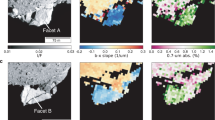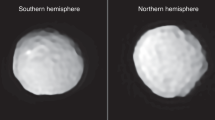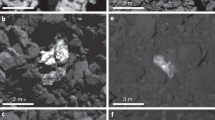Abstract
The asteroid (162173) Ryugu and other rubble-pile asteroids are likely re-accumulated fragments of much larger parent bodies that were disrupted by impacts. However, the collisional and orbital pathways from the original parent bodies to subkilometre rubble-pile asteroids are not yet well understood1,2,3. Here we use Hayabusa2 observations to show that some of the bright boulders on the dark, carbonaceous (C-type) asteroid Ryugu4 are remnants of an impactor with a different composition as well as an anomalous portion of its parent body. The bright boulders on Ryugu can be classified into two spectral groups: most are featureless and similar to Ryugu’s average spectrum4,5, while others show distinct compositional signatures consistent with ordinary chondrites—a class of meteorites that originate from anhydrous silicate-rich asteroids6. The observed anhydrous silicate-like material is likely the result of collisional mixing between Ryugu’s parent body and one or multiple anhydrous silicate-rich asteroid(s) before and during Ryugu’s formation. In addition, the bright boulders with featureless spectra and less ultraviolet upturn are consistent with thermal metamorphism of carbonaceous meteorites7,8. They might sample different thermal-metamorphosed regions, which the returned sample will allow us to verify. Hence, the bright boulders on Ryugu provide new insights into the collisional evolution and accumulation of subkilometre rubble-pile asteroids.
This is a preview of subscription content, access via your institution
Access options
Access Nature and 54 other Nature Portfolio journals
Get Nature+, our best-value online-access subscription
$29.99 / 30 days
cancel any time
Subscribe to this journal
Receive 12 digital issues and online access to articles
$119.00 per year
only $9.92 per issue
Buy this article
- Purchase on Springer Link
- Instant access to full article PDF
Prices may be subject to local taxes which are calculated during checkout




Similar content being viewed by others
Data availability
All images and input data used in this study are available at the JAXA Data Archives and Transmission System (DARTS) at http://www.darts.isas.jaxa.jp/pub/hayabusa2/paper/Tatsumi_2020, and higher-level data products will be available in the Small Bodies Node of the NASA Planetary Data System (https://pds-smallbodies.astro.umd.edu/) one year after mission departure from the asteroid.
References
Fujiwara, A. et al. The rubble-pile asteroid Itokawa as observed by Hayabusa. Science 312, 1330–1334 (2006).
Watanabe, S. et al. Hayabusa2 arrives at the carbonaceous asteroid 162173 Ryugu—a spinning top-shaped rubble pile. Science 364, 268–272 (2019).
Lauretta, D. S. et al. The unexpected surface of asteroid (101955) Bennu. Nature 568, 55–60 (2019).
Sugita, S. et al. The geomorphology, color, and thermal properties of Ryugu: implications for parent-body processes. Science 364, eaaw0422 (2019).
Kitazato, K. et al. The surface composition of asteroid 162173 Ryugu from Hayabusa2 near-infrared spectroscopy. Science 364, 272–275 (2019).
Nakamura, T. et al. Itokawa dust particles: a direct link between S-type asteroids and ordinary chondrites. Science 333, 1113–1116 (2011).
Hiroi, T. et al. Thermal metamorphism of the C, G, B, and F asteroids seen from the 0.7 μm, 3 μm, and UV absorption strengths in comparison with carbonaceous chondrites. Meteorit. Planet. Sci. 31, 321–327 (1996).
Hiroi, T. et al. Reflectance spectra (UV-3µm) of heated Ivuna (CI) meteorite and newly identified thermally metamorphosed CM chondrites. In Lunar and Planetary Science Conference XXVII, abstr. 551–552 (Lunar and Planetary Institute, 1996).
Bowell, E. & Zellner, B. in Planets, Stars and Nebulae Studied with Photopolarimetry (ed Gehrels, T.) 381–404 (Univ. Arizona Press, 1974).
Marty, B. et al. Origins of volatile elements (H, C, N, noble gases) on Earth and Mars in light of recent results from the ROSETTA cometary mission. Earth Planet. Sci. Lett. 441, 91–102 (2016).
Sarafian, A. R. et al. Early accretion of water in the inner solar system from a carbonaceous chondrite–like source. Science 346, 623–626 (2014).
Morota, T. et al. Smaple collection from asteroid (162173) Ryugu by Hayabusa2: Implications for surface evolution. Science 368, 654–659 (2020).
Sasaki, S. et al. Production of iron nanoparticles by laser irradiation in a simulation of lunar-like space weathering. Nature 410, 555–557 (2001).
Michikami et al. Boulder size and shape distributions on asteroid Ryugu. Icarus 331, 179–191 (2019).
Michikami et al. Fragment shapes in impact experiments ranging from cratering to catastrophic disruption. Icarus 264, 316–330 (2016).
Bus, S. J. & Binzel, R. P. Phase II of the small main-belt asteroid spectroscopic survey: a feature-based taxonomy. Icarus 158, 146–177 (2002).
Nakamura, T. et al. Post-hydration thermal metamorphism of carbonaceous chondrites. J. Mineral. Petrol. Sci. 100, 260–272 (2005).
Applin, D. M. et al. Ultraviolet spectral reflectance of carbonaceous materials. Icarus 307, 40–80 (2018).
Grimm, R. E. & McSween, H. Y. Jr Water and thermal evolution of carbonaceous chondrite parent bodies. Icarus 82, 244–280 (1989).
Mainzer, A. et al. NEOWIDE observations of near-Earth objects: preliminary results. Astrophys. J. 743, 156 (2011).
DeMeo, F. & Carry, D. Solar System evolution from compositional mapping of the asteroid belt. Nature 505, 629–634 (2014).
Campins, H. et al. The origin of asteroid 162173 (1999 JU3). Astron. J. 146, 26 (2013).
Cellino, A. et al. The puzzling case of the Nysa–Polana family. Icarus 152, 225–237 (2001).
Bottke, W. F. Jr et al. Velocity distributions among colliding asteroids. Icarus 107, 255–268 (1994).
Bottke, W. F. Jr et al. The fossilized size distribution of the main asteroid belt. Icarus 175, 111–140 (2005).
Jutzi, M. et al. Fragment properties at the catastrophic disruption threshold: the effect of the parent body’s internal structure. Icarus 207, 54–65 (2010).
Campins, H. et al. The origin of asteroid 101955 (1999 RQ36). Astrophys. J. Lett. 721, L53–L57 (2010).
DellaGiustina, D. N. et al. Exogenic basalt on asteroid (101955) Bennu. Nat. Astron. https://doi.org/10.1038/s41550-020-1195-z (in the press).
Tatsumi, E. et al. Updated inflight calibration of Hayabusa2’s optical navigation camera (ONC) for scientific observations during the cruise phase. Icarus 325, 153–195 (2019).
Tatsumi, E. et al. Updated flat-fields of ONC-T/Hayabusa2 based on close encounter with Ryugu. In 50th Lunar and Planetary Science Conference, abstr. 1745 (Lunar and Planetary Institute, 2019).
Hapke, B. Bidirectional reflectance spectroscopy: 1. Theory. J. Geophys. Res. 86, 3039–3054 (1981).
Kameda, S. et al. Preflight calibration test results for optical navigation camera telescope (ONC-T) onboard the Hayabusa2 spacecraft. Space Sci. Rev. 208, 17–31 (2017).
Bus, S. & Binzel, R. P. Phase II of the Small Main-Belt Asteroid Spectroscopic Survey. Icarus 158, 146–177 (2002).
Bus, S. & Binzel, R. P. Small Main-Belt Asteroid Spectroscopic Survey, Phase II EAR-A-I0028-4-SBN0001/SMASSII-V1.0 (NASA Planetary Data System, 2003).
Clauset, A. et al. Power-law distributions in empirical data. SIAM Rev. 51, 661–703 (2009).
Alstott, J. et al. Powerlaw: a Python package for analysis of heavy-tailed distributions. PLoS ONE 9, e85777 (2014).
Iwata, T. et al. NIRS3: The Near Infrared Spectrometer on Hayabusa2. Space Sci. Rev. 208, 317–337 (2017).
Anderson, W. W. & Ahrens, T. J. Shock wave equations of state of chondritic meteorites. AIP Conf. Proc. 429, 115–118 (1998).
Flynn et al. Physical properties of the stone meteorites: implications for the properties of their parent bodies. Chem. Erde 78, 269–298 (2018).
Fujiwara, A. & Tsukamoto, A. Experimental study on the velocity of fragments in collisional breakup. Icarus 44, 142–153 (1980).
Benz, W. & Asphaug, E. Catastrophic disruptions revisited. Icarus 142, 5–20 (1999).
Acknowledgements
The Hayabusa2 spacecraft was developed and built under the leadership of JAXA, with contributions from DLR and CNES, and in collaboration with NASA, Nagoya University, University of Tokyo, NAOJ, University of Aizu, Kobe University, and other universities, institutes and companies in Japan. We thank many engineers, including N. Inaba of JAXA and T. Masuda, S. Yasuda, K. Matsushima and T. Ohshima of NEC Corp. for their dedicated work on the Hayabusa2 mission, K. Sato at NEC Corp. for ONC-T development, and S. Kashima at NAOJ for optical calculations. Funding: E.T. acknowledges financial support from the project ProID2017010112 under the Operational Programmes of the European Regional Development Fund and the European Social Fund of the Canary Islands (OP-ERDF-ESF), as well as the Canarian Agency for Research, Innovation and Information Society (ACIISI). S.W., T. Morota, M. Arakawa, T.O., T.N., N.N., M. Abe, S. Sasaki and S. Sugita were supported by KAKENHI from the JSPS (grant numbers 17H06459, 19H01951, 16H04044, 19K03958 and 18H01267) and the JSPS Core-to-Core program ‘International Network of Planetary Sciences’. T.H. acknowledges funding support from NASA Emerging World/Planetary Data Archiving and Restoration. D.D. acknowledges funding through the NASA Hayabusa2 Participating Scientist Program (grant number NNX16AL34G) and NASA’s Solar System Exploration Research Virtual Institute 2016 (SSERVI16) Cooperative Agreement (NNH16ZDA001N) for TREX (Toolbox for Research and Exploration). P.M. and M.A.B. acknowledge funding support from the French space agency CNES. P.M. also acknowledges funding from the European Union’s Horizon 2020 research and innovation programme under grant agreement no. 870377 (project NEO-MAPP) and from Academies of Excellence: Complex systems and Space, environment, risk, and resilience, part of the IDEX JEDI of the Université Côte d’Azur.
Author information
Authors and Affiliations
Contributions
E.T. coordinated co-author contributions, led the ONC-T data analyses and interpretations; ONC-T data acquisitions and reductions: R.H., N.S., Y. Yokota, M.Y., S. Sugita, T. Morota, S. Kameda, H. Sawada, M.M., T.K., E.T., C. Honda, K.O., H. Suzuki, M.I., K. Yoshioka, M.H., Y.C., C.S. and M.S.; NIRS3 data acquisitions and reductions: L.R., K.K., C.P., T.I., M. Abe and M. Ohtake; shape modeling and spacecraft trajectory: N.H. (Kobe), N.H. (Aizu). and Y. Yamamoto; science operations of spacecraft: S. Tanaka, F.T., S.N., S.K., T.Y., N.O., G.O., Y.M., K. Yoshikawa, S. Sugita, T.T., Y. Takei, A.F., H.T., Y. Yamamoto, T.O., M.Y., Y.S., K.S., N.H. (Kobe), Y.I., K.O., C.H., S.H., O.M., H.S., T. Shimada, S. Soldini, R.T., T.I., M.H., H.Y., M. Ozaki, M. Abe, M. Yoshikawa, T. Saiki, S.W. and Y. Tsuda; project administration: Y. Tsuda, S.W., M. Yoshikawa, T. Saiki, S. Tanaka, F.T., S.N., Y. Yamamoto, K.K., S. Sugita, N.N., M. Abe, S. Tachibana, M. Arakawa, H.I., M.I. and K.W.; interpretation and writing contribution: E.T., C.S., L.R., T.N., S. Sugita, T. Morota, M.P., M.M., S.W., T.H., M.T., N.S., D.D., M.A.B., P.M., H.Y. and J.d.L. All authors discussed the results and commented on the manuscript.
Corresponding author
Ethics declarations
Competing interests
The authors declare no competing interests.
Additional information
Publisher’s note Springer Nature remains neutral with regard to jurisdictional claims in published maps and institutional affiliations.
Extended data
Extended Data Fig. 1 Bright boulder morphologies.
Extended Data Fig. 2 Power index for boulder size distribution from close-up images.
The power index is calculated based on the maximum-likelihood fitting method by ref. 35. The cumulative boulder size distribution is expressed as \(N\left( { > D} \right) \propto D^{ - \alpha }\), where D is the diameter of the bright boulder, and α is the power-law index.
Extended Data Fig. 3 Normalized reflectance spectra of bright boulders (black lines) compared with the average spectrum of Ryugu (gray lines).
Lines are offset by 0.7 for clarity. The bright boulders which display two spectra were observed twice in different multiband image sets.
Extended Data Fig. 4
The locations and sizes of bright boulders.
Extended Data Fig. 5 Bright boulders (enclosed by red lines) in close-up images during the MINERVA-II deployment operation on 21 September 2018.
a, hyb2_onc_20180921_043010_tvf, altitude of 636 m (68 mm/pixel). b, hyb2_onc_20180921_041826_tvf, altitude of 335 m (36 mm/pixel). c, hyb2_onc_20180921_034938_tvf, altitude of 148 m (16 mm/pixel). d, hyb2_onc_20180921_040154_tvf, altitude of 75 m (8 mm/pixel). e, hyb2_onc_20180921_040634_tvf, altitude of 68 m (7 mm/pixel).
Extended Data Fig. 6 S-type bright boulders observed by NIRS3.
(left) The NIRS3 spectra of the area including bright boulders (black) and adjacent areas (gray). The footprint size of NIRS3 is in Extended Table 2. (right) The normalized spectra of area including bright boulders by the adjacent areas. Only the M13 shows small absorption around 2 µm.
Extended Data Fig. 7 Peak pressure during a collision between an ordinary chondrite and a carbonaceous chondrite.
The red solid and dashed lines indicate the average and standard deviation of compressive strength among ordinary chondrites, respectively39. The black solid and dashed lines indicate then peak pressure for the target densities of 2.2 g/cc and 1.2 g/cc (Ryugu bulk density), respectively.
Supplementary information
Supplementary Information
Supplementary methods, Figs. 1–6, and Tables 1 and 2.
Supplementary Data
The list of meteorite spectra used in Figs. 2 and 4.
Source data
Source Data Fig. 1
Original images used for Fig. 1 and size distribution of bright boulders.
Source Data Fig. 2
Bright boulder spectra, spectral slope-PC2’ values and the result of principal component analysis.
Source Data Fig. 3
Spectral slope and UV-index values of C-type bright boulders.
Source Data Fig. 4
NIRS3 spectra and calculated band I and band II values for all S-type bright boulders.
Source Data Extended Data Fig. 1
Original images used to compose Extended Data Fig. 1.
Source Data Extended Data Fig. 3
Bright boulder spectra.
Source Data Extended Data Fig. 5
Original images used to compose Extended Data Fig. 5.
Source Data Extended Data Fig. 6
NIRS3 spectra for the S-type bright boulders.
Rights and permissions
About this article
Cite this article
Tatsumi, E., Sugimoto, C., Riu, L. et al. Collisional history of Ryugu’s parent body from bright surface boulders. Nat Astron 5, 39–45 (2021). https://doi.org/10.1038/s41550-020-1179-z
Received:
Accepted:
Published:
Issue Date:
DOI: https://doi.org/10.1038/s41550-020-1179-z
This article is cited by
-
Insight into multi-step geological evolution of C-type asteroids from Ryugu particles
Nature Astronomy (2023)
-
The GAs Extraction and Analyses system (GAEA) for immediate extraction and measurements of volatiles in the Hayabusa2 sample container
Earth, Planets and Space (2022)
-
Environmental assessment in the prelaunch phase of Hayabusa2 for safety declaration of returned samples from the asteroid (162173) Ryugu: background monitoring and risk management during development of the sampler system
Earth, Planets and Space (2022)
-
Derivation of 1.064 μm normal albedos on the C-type asteroid Ryugu from laser pulse intensity measurement of the Hayabusa2 LIDAR
Earth, Planets and Space (2022)
-
Mid-infrared emissivity of partially dehydrated asteroid (162173) Ryugu shows strong signs of aqueous alteration
Nature Communications (2022)



